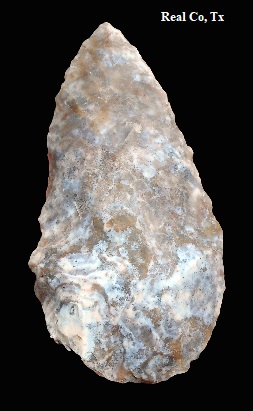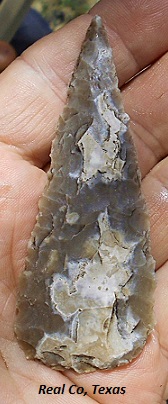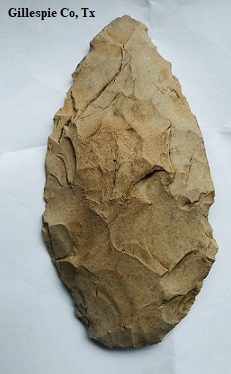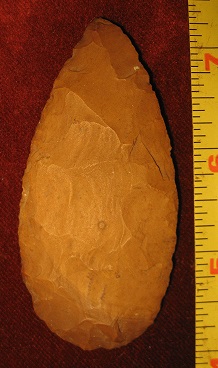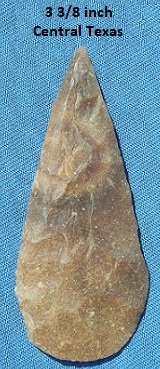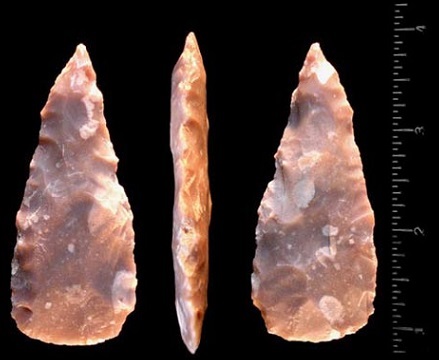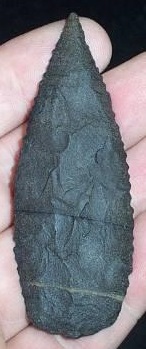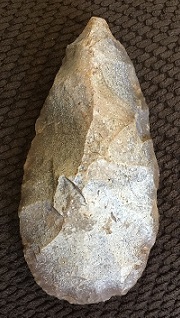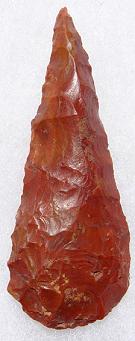Outline is Representative of Size and Shape: 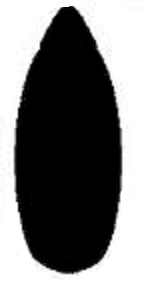
Name Details:
Identified By: Richard MacNeish
Named For:
Date Identified: 1950's
Type Site: Tamaulipas, Mexico
Identified By: Richard MacNeish
Named For:
Date Identified: 1950's
Type Site: Tamaulipas, Mexico
Point Validity: Valid type
MacNeish is distinguished anthropologist who identified this point during his work at Sierra De Tamaulipas Mexico. This type has been references in many professional publications and is considered a valid type.
MacNeish is distinguished anthropologist who identified this point during his work at Sierra De Tamaulipas Mexico. This type has been references in many professional publications and is considered a valid type.
Abasolo
Cluster: Description of Physical Characteristics and Flaking Pattern:
This is a medium to large (commonly 1.5 to 2.5 inches) ovoid blade with an elliptical cross section. The blade is excurvate and may vary from having the blade expand
from the tip to the base in a triangular shape, to curving out from the
tip, becoming widest about the mid-point to the bottom third of the blade, and curving back
in towards the base. The overall
shape is commonly described as a teardrop. The
blade is commonly beveled or steeply chipped on alternating edges, but
may vary to all edges. The base is convex with rounded basal corners forming a
semicircle (this is the key characteristic of this type) and commonly
has basal thinning. This point is formed using percussion flaking
with heavier pressure flaking used near the tip and lighter pressure
flaking along the base forming a random flaking pattern.
Size Measurements:
Length - 35 to 110 mm (average 53 to 60 mm), Width - 21 to 45 mm (average 25 to 30 mm), Thickness - 6 to 14 mm (average 11mm), (Suhm and Krieger, 1954 MacNeish, 1967)
Length - 35 to 110 mm (average 53 to 60 mm), Width - 21 to 45 mm (average 25 to 30 mm), Thickness - 6 to 14 mm (average 11mm), (Suhm and Krieger, 1954 MacNeish, 1967)
Commonly Utilized Material:
Additional Comments:
The Abasolo probably served as a knife and not a projectile point. It is similar to many regional points like the Tortugas, which has a straight base, and the Catan, which is smaller than the Abasolo. (Turner and Hester, 1985).
This is similar to the Covington Knife found in central Texas. The Covington Knife tends to be broader with more angular basal corners while the Abasolo tends to be narrower with rounded basal corners. The Refugio is similar, but is generally larger than the Abasolo.
This type is related to the Tortugas point, but is differentiated by the semicircular base. The Catan point has a similar outline, but is much smaller than the Abasolo. The Desmuke has a pointed base instead of the convex base of this point (Suhm and Krieger, 1954).
The Abasolo probably served as a knife and not a projectile point. It is similar to many regional points like the Tortugas, which has a straight base, and the Catan, which is smaller than the Abasolo. (Turner and Hester, 1985).
This is similar to the Covington Knife found in central Texas. The Covington Knife tends to be broader with more angular basal corners while the Abasolo tends to be narrower with rounded basal corners. The Refugio is similar, but is generally larger than the Abasolo.
This type is related to the Tortugas point, but is differentiated by the semicircular base. The Catan point has a similar outline, but is much smaller than the Abasolo. The Desmuke has a pointed base instead of the convex base of this point (Suhm and Krieger, 1954).
Distribution: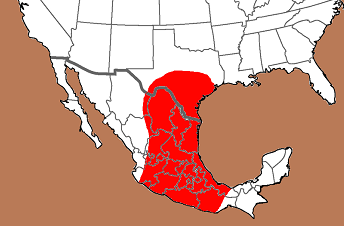

Distribution Comments:
This point is primarily found in the Rio Grande drainage of Texas and into southern Tamaulipas and eastern Nuevo Leon Mexico. This point has been reported in Mexico Valley, Tehuacan Valley, Cueva de la Nopaler Hidalgo. This point is found with decreasing frequency into the coastal regions and central Texas.
This point is primarily found in the Rio Grande drainage of Texas and into southern Tamaulipas and eastern Nuevo Leon Mexico. This point has been reported in Mexico Valley, Tehuacan Valley, Cueva de la Nopaler Hidalgo. This point is found with decreasing frequency into the coastal regions and central Texas.
Age / Periods:
Date: 7,000 - 5,000 B.P.
Cultural Period: Middle Archaic
Glacial Period: Middle Holocene
Culture:
Date: 7,000 - 5,000 B.P.
Cultural Period: Middle Archaic
Glacial Period: Middle Holocene
Culture:
Age Details:
Bell (1958) notes that this point continued for a much longer period of time in the Rio Grande valley, but are only associated with non-ceramic sites.
Bell (1958) notes that this point continued for a much longer period of time in the Rio Grande valley, but are only associated with non-ceramic sites.
Similar Points:
Catan, Chiconautla, Covington, Desmuke, Matamoros, Montgomery, Nogales, Refugio, Tortugas
Catan, Chiconautla, Covington, Desmuke, Matamoros, Montgomery, Nogales, Refugio, Tortugas
Other points in this cluster / Related points:

